One of the earliest windows to be installed at St Paul’s was the Kebbell window. The two-light window in the south minor transept is a memorial to Dr Mark Kebbell – a highly esteemed and loved member of the community. At his death a procession of up to 250 people followed his body to the burial site. He was remembered as “a warm friend, a skilful physician, and a man whose memory will long outlive his good deeds.”
Dr Mark Kebbell arrived from England to Wellington in 1857. He was the youngest of 12 children. As well as being a member of the Royal College of Surgeons, he was also the coroner for the district. He married Louisa Bowler in 1858 at St Paul’s. They had three children before Kebbell contracted scarlet fever. It is said that he stayed through the night nursing a young girl who was sick with the contagious bacterial disease and then caught it himself.

Scarlet fever is a highly infectious disease caused by streptococcal bacteria. It seems to have been introduced to New Zealand in the 1840s or early 1850s. In 1865, the year Kebbell died, the Evening Post reported:
“In the midst of our prosperity there has lingered an enemy to our peace, a thousand times worse than poverty – the fever. It is in vain we try to shut our eyes to the fact; it meets us at the corners of streets – now in the funeral of a child, followed by its sorrowing parents and friends, and ever and anon men and women succumb to the ravages of the insidious disease.”
 Dr Mark Kebbell died from scarlet fever in February 1865. In August of that year, his widow Louisa gave birth to their last son, naming him Mark.
Dr Mark Kebbell died from scarlet fever in February 1865. In August of that year, his widow Louisa gave birth to their last son, naming him Mark.
The window would have been made shortly thereafter, and put into the brand new church. It depicts two of the four evangelists, St Luke and St Mark. St Luke is appropriately the patron saint of artists, physicians, surgeons, students and butchers. He is usually represented by the winged ox or bull. St Mark is symbolised by a winged lion, a symbol of courage and monarchy. An article reviewing the churches of New Zealand pointed out the “handsome window” and its use of the evangelists, although questioning the good taste of the choice of subjects; it seems the anonymous reviewer was not so impressed with the use of St Mark purely for the name association.
It is interesting to note that the saint’s name panels in the window are actually the wrong way around. St Mark is always symbolised by the image of a winged lion, and this symbol is used in the little roundels (as shown below) around his body; but the window name says that this is St Luke; and likewise, St Luke is always symbolised as a bull; but in this window the roundels show a winged lion.


It is likely that the name plates were accidentally swapped during repairs, or when the window was moved from its original position in the church which is shown in the early image below. The window has also been moved from the left of the chancel to its current position. You can see it in its original place in this interior photograph from 1867.
Sources: Old St Paul’s Conservation Plan; Notes provided by Mrs Alice Bowes to T W Barrett 30 October 2003; George C. Kohn, Encyclopedia of Plague and Pestilence: From Ancient Times to the Present, New York, 2007; Wellington Independent, 7 February 1865; Timaru Herald, 25 August 1875; Evening Post, 25 April 1865.
Images: Modern photos of window, 2015, copyright Paul Scott http://paulscottinfo.ipage.com/nz/cathedrals/wellington/oldstpauls/tn.html; Historic photos: Wellington Hospital, Pipitea Street, Thorndon. Davis, William Henry Whitmore, 1812-1901. Ref: 1/2-230730-G. Alexander Turnbull Library; Interior view of St Pauls Pro-Cathedral, Wellington, New Zealand. Harris, George Frederick: Album of Wellington photographs. Ref: PA1-q-541-12-2. Alexander Turnbull Library.

